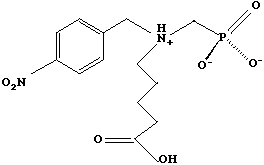
A SULFIDE OXIDATION CATALYTIC ANTIBODY. B.D. Santarsiero, L.C. Hsieh-Wilson, P.G. Schultz, & R.C. Stevens, Department of Chemistry, University of California, Berkeley, CA 94720 USA
A number of antibodies were found to catalyze the oxidation of a p-nitro-aromatic-sulfide to the corresponding sulfoxide with sodium periodate as a cofactor.

Earlier work on the mechanism of the oxidation lead to the description of two potential transition states, both accomodating a positive charge on the sulfur atom and an increase in the negative charge of the periodate. The hapten (below), based on these transition states, was then designed.

The antibody 28B4 was the most efficient, binding the hapten with a Kd of 52nM and catalyzing the oxidation with a kcat of 8.2s-1; kcat/Km=1.9x105M-1s-1. To better understand the catalytic mechanism of 28B4 and further examine the role of hapten binding, the structure of the Fab portion of the antibody was determined in the presence and absence of hapten. Both structures are found in space group P1. With hapten, the structure was refined to 1.7Å resolution with R=0.209 and R(free)=0.279; the cell parameters are a=52.7Å, b=58.2Å, c=43.2Å, (=94.3(, (=113.8(, (=78.9(. Without hapten, the structure was refined to 2.2Å resolution with R=0.212 and R(free)=0.256; the cell parameters are a=47.2Å, b=58.6Å, c=43.4Å, (=95.3(, (=103.2(, (=93.6(. Details on each of the structural determinations and results will be discussed.